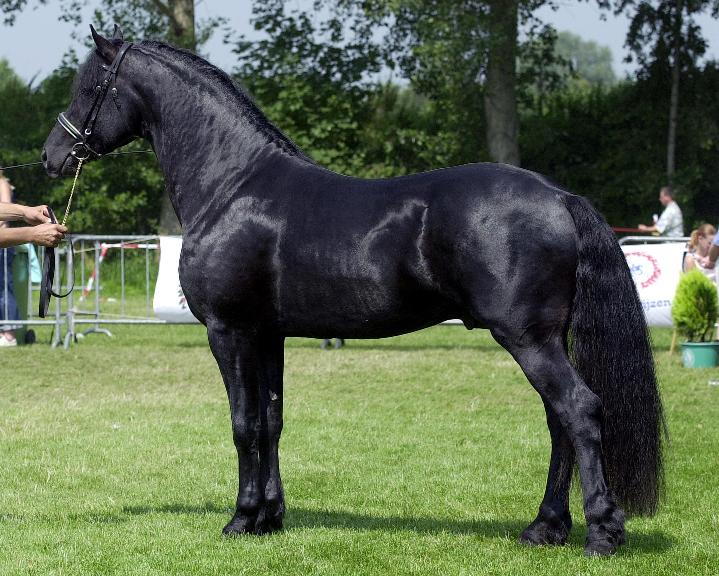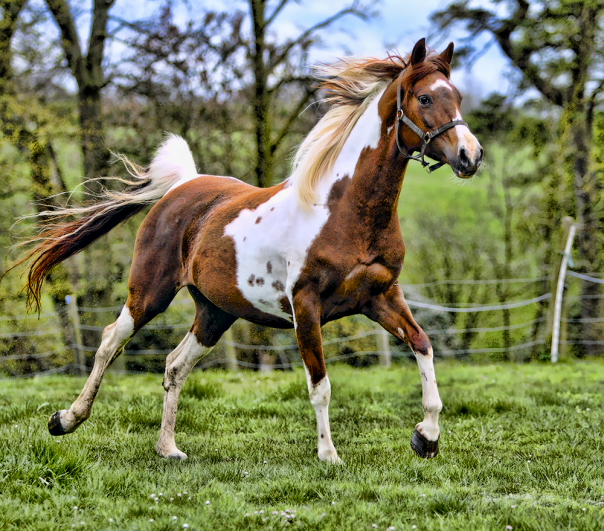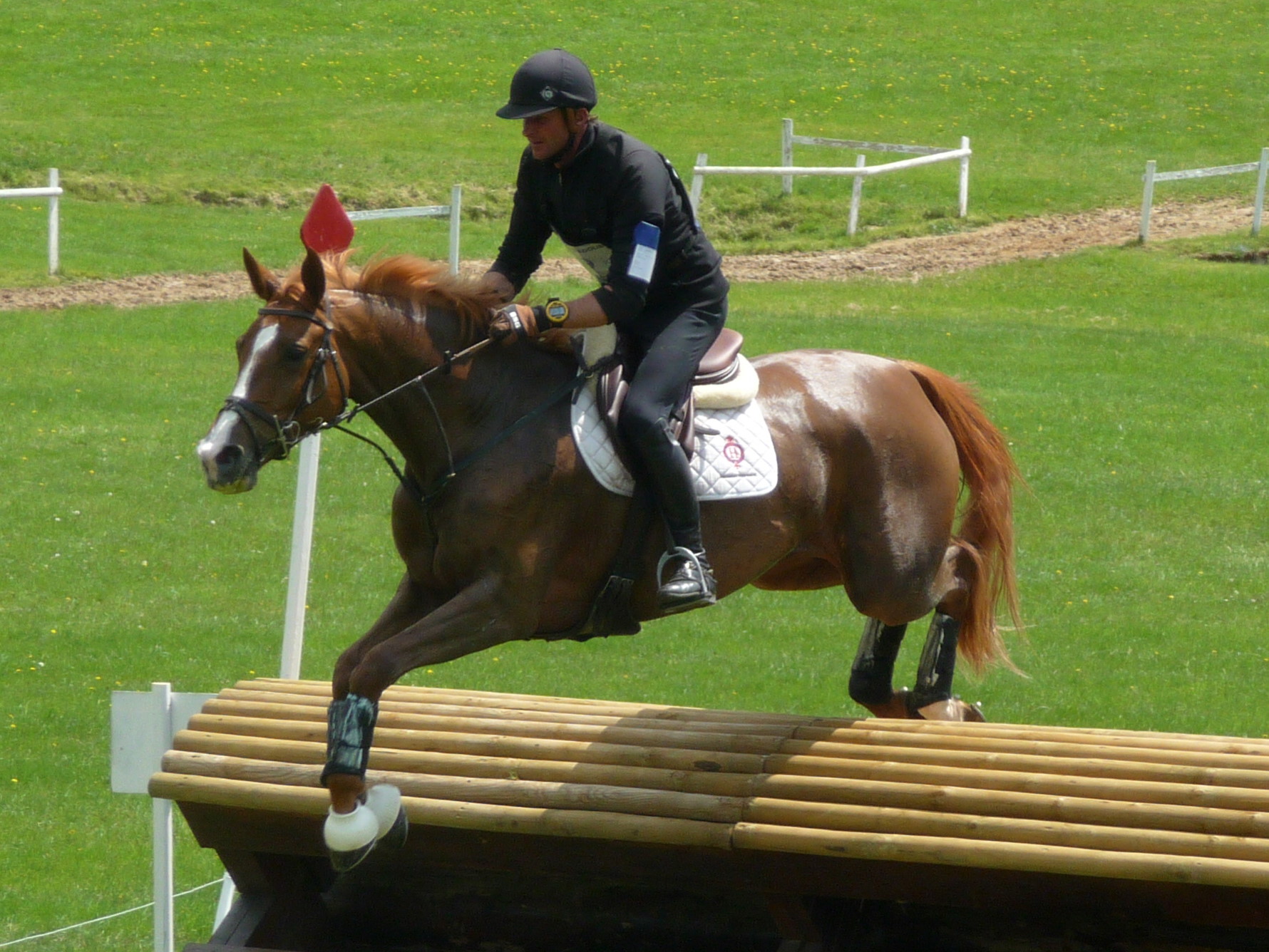|
Part-Arabian
A part-Arabian, partbred Arabian or, less precisely, half-Arabian, is a horse with documented amounts of Arabian horse breeding but not a purebred. Because the Arabian is deemed to be a breed of purebred horse dating back many centuries, the modern breed registry, breed registries recognized by the World Arabian Horse Organization generally have tightly closed stud books which exclude a horse from registration if it is found to contain any outside blood. However, Arabian breeding has also been used for centuries to add useful traits to countless other horse breeds. In the modern era, crossbreeding has been popular to combine the best traits of two different breeds, such as color, size, or ability to specialize in a particular equestrianism, equestrian discipline. Thus, in the modern era, the desire to recognize and acknowledge Arabian breeding in non-purebred horses has led to the formation of partbred sections in many purebred Arabian registries in order to record the pedigrees ... [...More Info...] [...Related Items...] OR: [Wikipedia] [Google] [Baidu] |
Arabian Horse
The Arabian or Arab horse ( ar, الحصان العربي , DIN 31635, DMG ''ḥiṣān ʿarabī'') is a horse breed, breed of horse that originated on the Arabian Peninsula. With a distinctive head shape and high tail carriage, the Arabian is one of the most easily recognizable horse breeds in the world. It is also one of the oldest breeds, with archaeological evidence of horses in the Middle East that resemble modern Arabians dating back 4,500 years. Throughout history, Arabian horses have spread around the world by both war and trade, used to improve other breeds by adding speed, refinement, endurance, and strong bone. Today, Arabian bloodlines are found in almost every modern breed of riding horse. The Arabian developed in a desert climate and was prized by the nomadic Bedouin people, often being brought inside the family tent for shelter and protection from theft. Selective breeding for traits, including an ability to form a cooperative relationship with humans, create ... [...More Info...] [...Related Items...] OR: [Wikipedia] [Google] [Baidu] |
Arabian Horse Association
The Arabian Horse Association (AHA) is the single national organization that is the only breed registry that registers Arabian horses in the United States. It also works with the United States Equestrian Federation to sanction horse shows and license judges for Arabian horses. The AHA was formed by a merger between the International Arabian Horse Association (IAHA) and the Arabian Horse Registry of America (AHRA) in 2003. AHRA was the older of the two organizations, a breed registry founded in 1908. IAHA, founded in 1950, organized to "meet the breeding, competitive and recreational interests of all Arabian horse owners", and also maintained a Half-Arabian and Anglo-Arabian registry. Arabian horse shows AHA shows are for purebred Arabian, Half-Arabian, and Anglo-Arabian horses only. The shows consist of Arabian Community Shows that allow exhibitors to get a start in the show ring, followed by "Class A" shows rated by the United States Equestrian Federation and the AHA, whic ... [...More Info...] [...Related Items...] OR: [Wikipedia] [Google] [Baidu] |
Pintabian
The Pintabian horse is an American part-Arabian horse breed. It has over 99% Arabian blood, but also exhibits the tobiano color pattern, which is not found in purebred Arabians. The registry began using the term "Pintabian" in 1992 and trademarked the word in 1995. which is the official registering authority for Pintabian horses worldwide. History Foundation Pintabian horse breeders developed the breed by backcrossing tobiano horses to purebred Arabians for a minimum of seven generations until a strain of tobiano marked horses over 99% Arabian blood had been developed, at which point the breed was considered a purebred horse breed in its own right. The Pintabian Horse Registry was established in 1992. Characteristics The conformation of Pintabian horses reflects the same ideal desired for the Arabian. The defining characteristics are their coat pattern and percentage of Arabian blood. Pintabian horses have a small muzzle with large nostrils and big, wide set eyes. Their foreh ... [...More Info...] [...Related Items...] OR: [Wikipedia] [Google] [Baidu] |
AraAppaloosa Hunter 02
The AraAppaloosa, also known as the Araloosa, Arappaloosa and the Ara-Appaloosa, is a part-Arabian horse breed that is the result of a cross between an Arabian horse and an Appaloosa, combining the refined phenotype of the Arabian with the leopard-spotted coloring of the Appaloosa. As both breeds are noted for endurance and intelligence, the resulting cross is usually able to excel at endurance riding as well as other disciplines performed by either breed, including ranch work, and a variety of horse show disciplines. An AraAppaloosa with one purebred Arabian parent may be registered as a half-Arabian with the Arabian Horse Association, and because the Appaloosa breed still has an open stud book to horses of Arabian breeding, many Arappaloosas can also be registered with the Appaloosa Horse Club (ApHC). However, they also have their own organization, the AraAppaloosa and Foundation Breeders' International (AAFBI). History The AAFBI was established in an effort to protect ... [...More Info...] [...Related Items...] OR: [Wikipedia] [Google] [Baidu] |
Quarab
The Quarab is a horse breed from the United States, developed from a part-Arabian cross of Arabian horses, American Quarter Horses and Paint horses. Members of the breed are found that resemble all three of the foundation breeds, leading to three recognized types: Straight or Foundation (an even cross between the Arabian and stock horse types), Stock (a heavier emphasis on stock horse breeding) and Pleasure (a heavier emphasis on Arabian breeding). Although there have been records of crosses between the three breeds throughout the history of their respective registries, the first Quarab registry was formed in 1984, but later went out of business. In 1999, the International Quarab Horse Association was formed and remains the leading force in Quarab breeding. In order to be registered with the IQHA, horses must have at least 1/8 blood from both the Arabian and stock horse types. Breed characteristics Quarabs are found that have characteristics of both Arabian and stock horse (Quar ... [...More Info...] [...Related Items...] OR: [Wikipedia] [Google] [Baidu] |
World Arabian Horse Organization
The World Arabian Horse Organization (WAHO) is the world organization for the preservation, improvement and preservation of Arabian horses. WAHO grants membership to nations after examination of national breeding stud book A breed registry, also known as a herdbook, studbook or register, in animal husbandry and the hobby of animal fancy, is an official list of animals within a specific breed whose parents are known. Animals are usually registered by their breeders ...s, and review of regulations for each country. Candidates for membership External links Official site {{Authority control Horse breed registries Equestrian organizations Arabian and part-Arabian horses ... [...More Info...] [...Related Items...] OR: [Wikipedia] [Google] [Baidu] |
Anglo-Arabian
The Anglo-Arabian or Anglo-Arab is a crossbred, part-Arabian horse that now also has its own status as a horse breed. It is the result of a Thoroughbred (hence, the prefix "Anglo") being crossed with an Arabian. The cross can be made between a Thoroughbred stallion and an Arabian mare, or vice versa. It can also be a cross between either an Anglo-Arab and a Thoroughbred or, alternatively, an Anglo-Arab and an Arabian. Another permitted cross is between two Anglo-Arabians. No matter the cross, a horse must have a minimum 12.5% of Arabian blood to be considered an Anglo-Arabian. France is one of the greatest producers of Anglo-Arabians. The French Anglo-Arab traces back to two stallions: the Arabian stud Massoud and Aslam, a "Turkish" horse, probably of the now-extinct Turkoman or "Turkmene" breed. These Syrian imports were then crossed with a trio of Thoroughbreds, specifically, the Comus Mare, the Selim Mare, and Daer. Some years later, three of their daughters — Clovi ... [...More Info...] [...Related Items...] OR: [Wikipedia] [Google] [Baidu] |
AraAppaloosa
The AraAppaloosa, also known as the Araloosa, Arappaloosa and the Ara-Appaloosa, is a part-Arabian horse breed that is the result of a cross between an Arabian horse and an Appaloosa, combining the refined phenotype of the Arabian with the leopard-spotted coloring of the Appaloosa. As both breeds are noted for endurance and intelligence, the resulting cross is usually able to excel at endurance riding as well as other disciplines performed by either breed, including ranch work, and a variety of horse show disciplines. An AraAppaloosa with one purebred Arabian parent may be registered as a half-Arabian with the Arabian Horse Association, and because the Appaloosa breed still has an open stud book to horses of Arabian breeding, many Arappaloosas can also be registered with the Appaloosa Horse Club (ApHC). However, they also have their own organization, the AraAppaloosa and Foundation Breeders' International (AAFBI). History The AAFBI was established in an effort to protect ... [...More Info...] [...Related Items...] OR: [Wikipedia] [Google] [Baidu] |
National Show Horse
The National Show Horse originated as a part-Arabian cross between an American Saddlebred and an Arabian horse. It is now established as a separate breed, since the founding of a breed registry in August 1981.Dutson ''96 Horse Breeds of North America'' p. 189-190 Registered animals today may be the offspring of registered NSH parents or may be a combination between an American Saddlebred, Arabian, and a National Show Horse. Non-NSH mares and stallions must be registered with their appropriate registries, and stallions who are Arabian or Saddlebred must additionally be nominated and approved by the NSHR board of directors. Although any combination of these three breeds may be used, as of December 1, 2009 there must be at least 50% Arabian blood in the horse to be registered, up to 99% Arabian blood (formerly 25% minimum Arabian blood was required for registry).NSHR Press Release Is Your Horse Now Eligible for NSH Registration?' Breed characteristics The National Show Horse combi ... [...More Info...] [...Related Items...] OR: [Wikipedia] [Google] [Baidu] |
Appaloosa
The Appaloosa is an American horse breed best known for its colorful spotted coat pattern. There is a wide range of body types within the breed, stemming from the influence of multiple breeds of horses throughout its history. Each horse's color pattern is genetically the result of various spotting patterns overlaid on top of one of several recognized base coat colors. The color pattern of the Appaloosa is of interest to those who study equine coat color genetics, as it and several other physical characteristics are linked to the leopard complex mutation (LP). Appaloosas are prone to develop equine recurrent uveitis and congenital stationary night blindness; the latter has been linked to the leopard complex. Artwork depicting prehistoric horses with leopard spotting exists in prehistoric cave paintings in Europe. Images of domesticated horses with leopard spotting patterns appeared in artwork from Ancient Greece and Han dynasty China through the early modern period. In North A ... [...More Info...] [...Related Items...] OR: [Wikipedia] [Google] [Baidu] |
719 Dark Ynte Neu
__NOTOC__ Year 719 (Roman numerals, DCCXIX) was a common year starting on Sunday (link will display the full calendar) of the Julian calendar. The denomination 719 for this year has been used since the early medieval period, when the Anno Domini calendar era became the prevalent method in Europe for naming years. Events By place Byzantine Empire * Ex-Emperor Anastasios II starts a revolt against Leo III the Isaurian, Leo III with considerable support, including auxiliaries provided by Tervel of Bulgaria, Tervel, emperor (''khagan'') of the Bulgarian Empire. His attack on Constantinople fails; Anastasios is captured and is put to death (by Decapitation, beheading), on the orders of Leo. Europe * Islamic invasion of Gaul#Umayyad conquest of Septimania, Umayyad conquest of Gaul (first major Muslim attack upon Visigothic Kingdom, Visigothic Septimania, in southern France): Governor Al-Samh ibn Malik al-Khawlani, Al-Samh takes or re-takes Narbonne (Arbouna for the Arab peo ... [...More Info...] [...Related Items...] OR: [Wikipedia] [Google] [Baidu] |
Morab
The Morab is an American breed of horse originally developed through the cross-breeding of Arabian and Morgan horses. The breeding of Morab horses began in the late 1880s with the intent of creating a fine carriage horse that was still substantial enough for moderate farm labor. History The Morab originated in the late nineteenth century as a result of cross-breeding of Arabian and Morgan stock; it retains some characteristics of each breed. The first Morab registry was created in 1973. Prior to this, Morabs were primarily undocumented horses bred for type. Many early Morabs were registered with the American Morgan Horse Association, as the Morgan studbook was still open that time, and these horses have since been fully assimilated into the Morgan breed. William Randolph Hearst was a Morab breeder, and is credited with the coinage of the name of the breed. Characteristics The Morab usually stands between at the withers, but may reach . It may be of any solid color, i ... [...More Info...] [...Related Items...] OR: [Wikipedia] [Google] [Baidu] |








